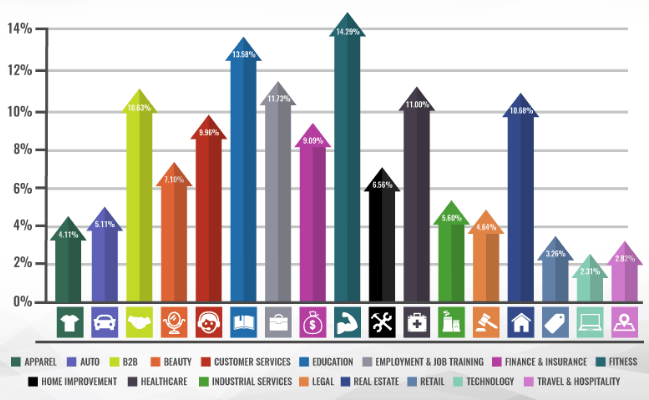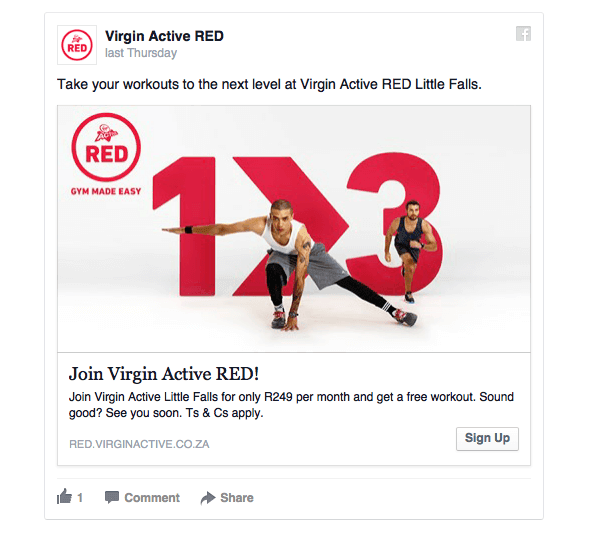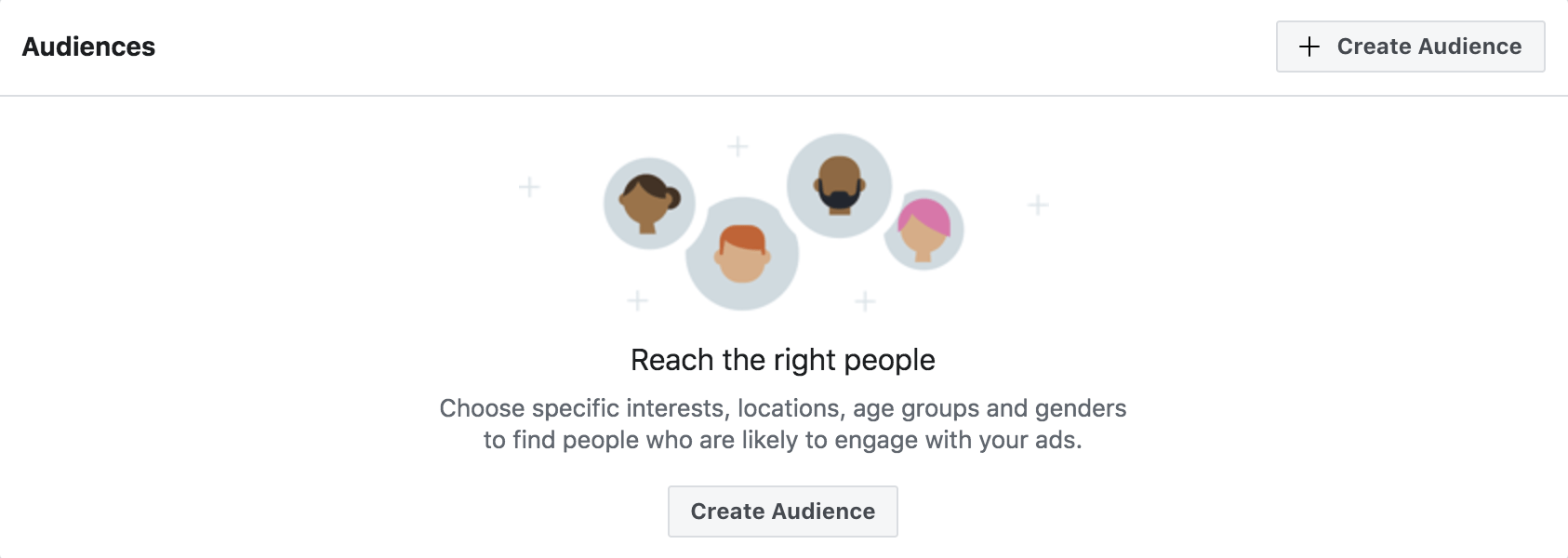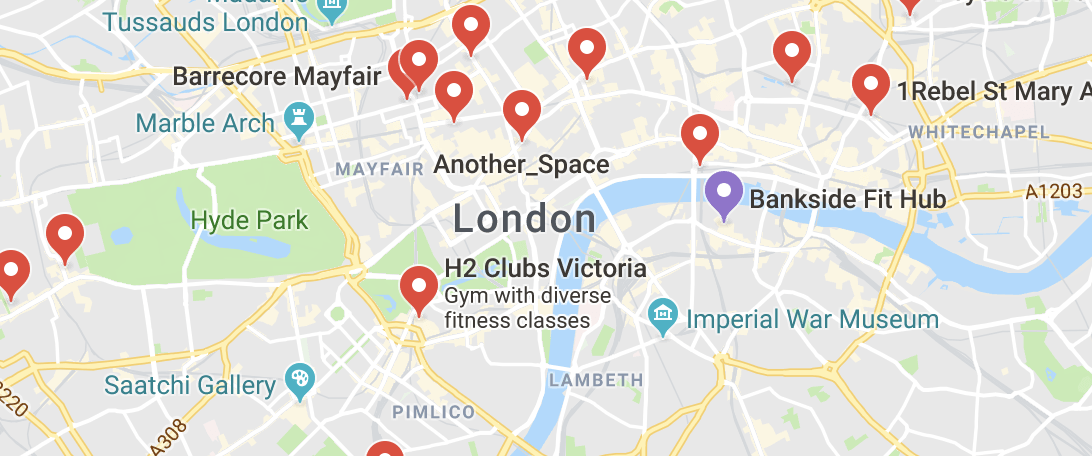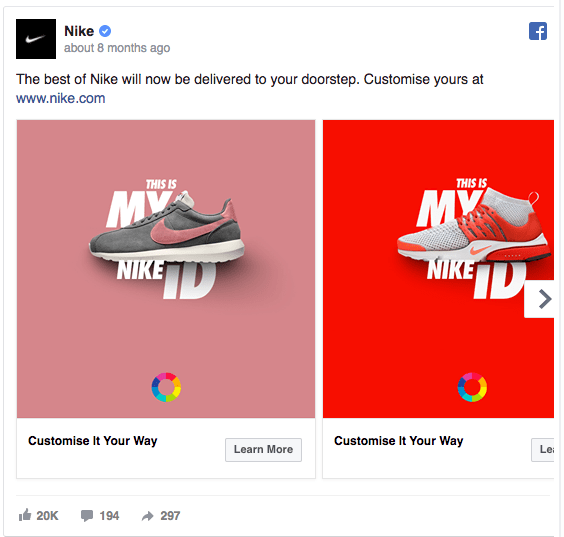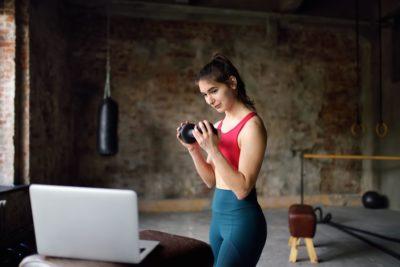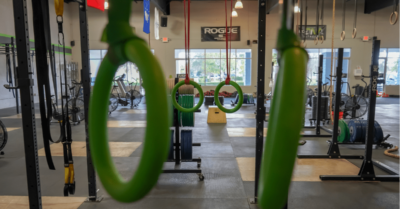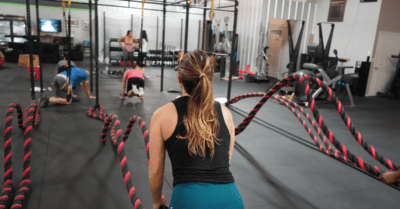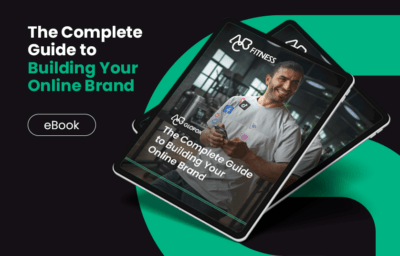The options for modern-day marketing are endless. Video content, guerrilla campaigns, email marketing; it’s easy to get swept away by the never-ending choices. To succeed in your marketing efforts, you need to focus your time, strategy, and budget into the areas that have the most significant impact and audience.
Right now, that area is Facebook Ads.
Digital marketing spend now accounts for an impressive 51% of total advertising spend in the US and in a recent survey, 78% of American consumers say they’ve discovered products on Facebook.
In this article, we’ll outline how powerful Facebook Ads are in the fitness industry, why so many small businesses fail with Facebook advertising and what makes a good Facebook ad, with examples you can use to promote your fitness business.
Social Media in 2019
Social media use is higher than it’s ever been, and it’s only set to grow. Around 45% of the world’s population use social media, 60% claim they are always connected, and 98% have used it in the last month. The average user is currently spending 2 hrs and 23 minutes of their day on social media.
Coined by marketing guru Gary Vaynerchuk as the “biggest, baddest social network,” Facebook accounts for the majority of that time, at an astonishing 58 minutes per day.

With 23%year on year growth, 80 million small businesses now have a Facebook page, and 6 million of these use the platform for advertising.
Are Facebook Ads Worth It?
Compared to other online marketing channels, like Google Adwords, lead generation is a fraction of the price with Facebook ads. There’s a massive choice of ad types available on the platform, and there are customizable options to suit every ad spend budget.
We can see that businesses are advertising on Facebook; and that there is a massive audience reach potential. But are Facebook ads effective for small businesses?
In the next part of this article, we’ll explore why 62% of small businesses are failing with Facebook ads to help you decide if your gym should be advertising on Facebook.
Spoiler alert: The answer is 100% yes. Across 17 different industries that use Facebook for advertising; the fitness industry has the highest conversion rates by far.
Source: www.wordstream.com
So if you’ve previously tried Facebook advertising for your fitness business and didn’t get great results, the question is – where did you go wrong? There are 4 key areas that small businesses underestimate when it comes to Facebook advertising. Luckily, there are also 4 ways you can make sure that your gym doesn’t make the same mistakes.
4 Reasons Small Businesses Fail With Facebook Ads
To create, manage, and optimize a Facebook advertising campaign is no easy task for small businesses. Knowing how to target and reach an audience and create content that resonates with them takes practice. But from the beginning, Facebook advertising needs to be treated like any marketing campaign; with a solid strategy. While insane traffic and conversion might not happen overnight; nobody wants to throw money at advertising that doesn’t work in the long-run. If you want to create a campaign that gets results, steer clear of the following common mistakes that small businesses make.
1. Unclear Strategy
Goal-setting is a crucial part of running any business. As a fitness business owner, having goals extends to your customers too. How do they improve their fitness with no goal to work toward?
All small businesses need to apply this goal mindset across the whole business; especially when it comes to marketing strategy. If you’re not tracking, measuring, testing, and improving results, there’s no point in marketing or advertising at all. How can you expect a campaign to deliver the results you want if you haven’t defined what they are, or how you’ll measure them?
Without a background or experience in marketing, defining a clear strategy can be challenging for small business owners. Often, they are already responsible for a lot of elements of the business and time is limited – especially when the business is still growing.
There is enormous potential to grow your fitness business with Facebook. But if you don’t know how you want to use the platform, or what you want to achieve, you’ll struggle. It’s crucial to make this step a priority if you’re going to create successful campaigns.
2. A Lack of Understanding
As highlighted, running a business is not easy. Juggling a range of responsibilities that all need your full attention is challenging, but marketing is one of the most critical aspects. It doesn’t matter how great your fitness studio is, or how effective your classes are if no one knows about them.
In the case of Facebook ads, it seems that many small business owners don’t take the time to understand how content marketing actually works. Facebook ads don’t magically set themselves up and start working for your business. You have to know what to do with them. And if you’re not sure what to do with them, you need to make this decision a priority.
With limited available time and a drive to succeed quickly, it’s easy to see why many small businesses rush into Facebook advertising expecting magical results.
But that’s just not how Facebook ads work. A great advertising campaign takes proper planning, clear strategy, testing, and most importantly; patience.
3. Poor Audience Targeting
Facebook advertising delivers enormous reach potential, but conversion for small businesses will still be poor without a defined target audience. What good is a killer Facebook ad campaign if the audience viewing it just isn’t interested?
Many small businesses, especially if they are new to advertising on Facebook, will run ads on generic audience segmentation. The scope of potential customers is too vast for this tactic to work. The campaign is doomed to fail from the start. While advertising in this way will still bring plenty of impressions; the conversion will be poor. At the end of the day, you don’t want to pay for ads that don’t provide a return. It’s a waste of your time and money.
Facebook’s targeting capabilities are so in-depth, there’s really no excuse to create a campaign without narrowing down your audience. The platform collects a lot of information from its users. Personal interests, purchase history, lifestyle metrics, age, and location are just some of its basic profiling. With tools including custom audiences, lookalike audiences, and audience insights; the data is gold for your advertising strategy. We’ll explore these tools a little later when outlining what makes a good Facebook ad campaign.
4. Poor Creative
Once audience targeting is locked-down, and you know exactly who will see your ads; the next hurdle is the visual appeal of the ads themselves. Small businesses often overlook this aspect of Facebook advertising in one major way. Much like audience targeting, the mistake is taking a generic approach to the creative aspect of the ad itself.
Ad ‘Creative’ includes the chosen copy, call to action, and the image/video content that is being promoted. Everything needs to be specific. A gym that offers a variety of classes can’t convey the benefits of each class in one ad.
Virgin Active is a huge brand, and we’ve definitely seen more defined, targeted ads from them, but this particular example is as generic as a gym ad can be. Smaller fitness businesses can’t afford to advertise in this way; the fitness industry is too competitive.
Say, for example, you’re a boutique studio that offers a range of classes, and you’re serving one generic Facebook Ad.
Your goal is to get signups specifically for your yoga, boxing, spin, and HIIT classes.
A competitor in your local area runs similar classes to your studio; they also want to increase signups for the same classes. They target their audience based on interests, the pages they have visited on the studio website, and their location. They serve 4 separate ads, using different, relevant content and copy to target these prospects.
Which studio is most likely to get a high conversion rate from their ads?
Ad creative shouldn’t be overlooked, and it’s easier than you’d think to fall into the trap of creating poor campaigns. An effective Facebook ad needs to use specific content and target a specific audience. We’ll highlight the best practices for this in the next section.
What Makes a Good Facebook Ad
Think of Facebook advertising like a fitness journey: If you’re not getting the results you want, you don’t just give up. If you’re prepared to persevere and make adjustments as you go, you’ll get the results you want. Below, we’ve outlined the key aspects of a good Facebook ad, with examples to help you apply them to your fitness business.
1. Defined Target Audience
The Top 10 Barriers
Slowing Your Fitness
Business Growth
Discover more Previously, we’ve discussed how to define your target audience on Facebook, and that’s because it’s an integral part of any Facebook ad campaign. Whether it’s demographics like behaviors, interests, connections, or location, Facebook lets you get picky with targeting. You can then layer the options to ensure your ads get shown to your perfect niche audience.
When it comes to the fitness industry, remember that as a studio, health club, or gym: your target audience already has a specific pain point. Weight-loss, toning up, the desire to generally live a healthier lifestyle; whichever fitness niche this audience wants, your brand offers the solution.
If you’ve tried and failed with Facebook ads in the past, you need to assess where you may have gone wrong. Was it with exploring and targeting demographics? While the intricacies of Facebook’s targeting options are endless; if you’re new to Facebook advertising, it’s easy enough to start with the basics. Think age, location, and interests. Using location as an example; say your ads were served to an entire country, but only 1% of that audience found your content relevant. The budget or ad spend may have been high, but your conversion rate will have been low.
When you create a Facebook ad campaign, one of the first things you should know is who you want to see your ads. Who doesn’t know your brand yet, but would want to? Get a crystal clear idea of your target member in mind and tailor your content specifically to them.
Say you’re a spin studio based in South West London; again we’ll use location to demonstrate how to make sure your ad is targeted well.
London is huge, and there are a lot of spin studios in the city. A potential member who lives 20 miles away from your studio probably doesn’t want to travel 20 miles to go to a spin class. So don’t waste your budget on them. You don’t want to create an ad that is served to the whole of London; it’s too vast an area for the content to be relevant for everyone who sees it. This would only end in wasted spend. Be specific and set your location within a fair radius of your studio.
The location demographics on Facebook don’t just stop at where people live; the platform also has insights on where they work. So with this example of a prospect who lives 20 miles away; if they work near your studio and you’re targeting the area correctly, they will still see the ad.
Targeting in this way means that you’re not wasting spend on people who live far away and don’t visit your area often. Keeping ad targeting options relevant to your location will give you better conversion and lead to more sales.
Regularly testing and changing aspects of your targeting is the only way to learn what works and what doesn’t. But once you’ve found an audience that converts well; Facebook makes it easy to find your next batch of leads.
With “Lookalike Audiences,” you can target new users who are similar to the group you’ve had success with. They’ll naturally be more inclined to find your brand interesting. You can even further define targeting options to ensure the lookalike audience is an accurate representation of your target consumers.
2. Strategy with Clear-Cut Goals
Having a plan with clear goals and objectives is crucial for any marketing campaign. It allows you to track and monitor content performance and tweak ads when necessary. So, before you even open your Ads Manager, ask yourself 3 questions:
- What is your campaign objective
- Who is your target audience
- How will you measure the results
For example, let’s say that your objective is to raise brand awareness for your studio. Firstly, you want to define your audience. As mentioned earlier, you can initially focus this on basic demographics such as location, age, and interest if you’re new to Facebook ads.
Follow the steps to set up your ad and make sure to optimize your campaign for the website and video clicks. Selecting this optimization will expand your reach and in turn, increase brand awareness. Try to promote the content to the largest defined audience possible; you want the content to be relevant to viewers and also to be seen by a lot of people.
If you’re just getting started with this particular goal for your Facebook ads, it’s a good idea to try out carousel ads. A Kinetic Social study shows that carousel ads have up to 10x higher CTR than static sponsored posts on Facebook. It’s also worth noting that people look at video content on Facebook 5x longer than a static post. From these statistics, it’s safe to say that you should test a few different types of ad content to see what your audience responds best to. And to veer away from completely static content!
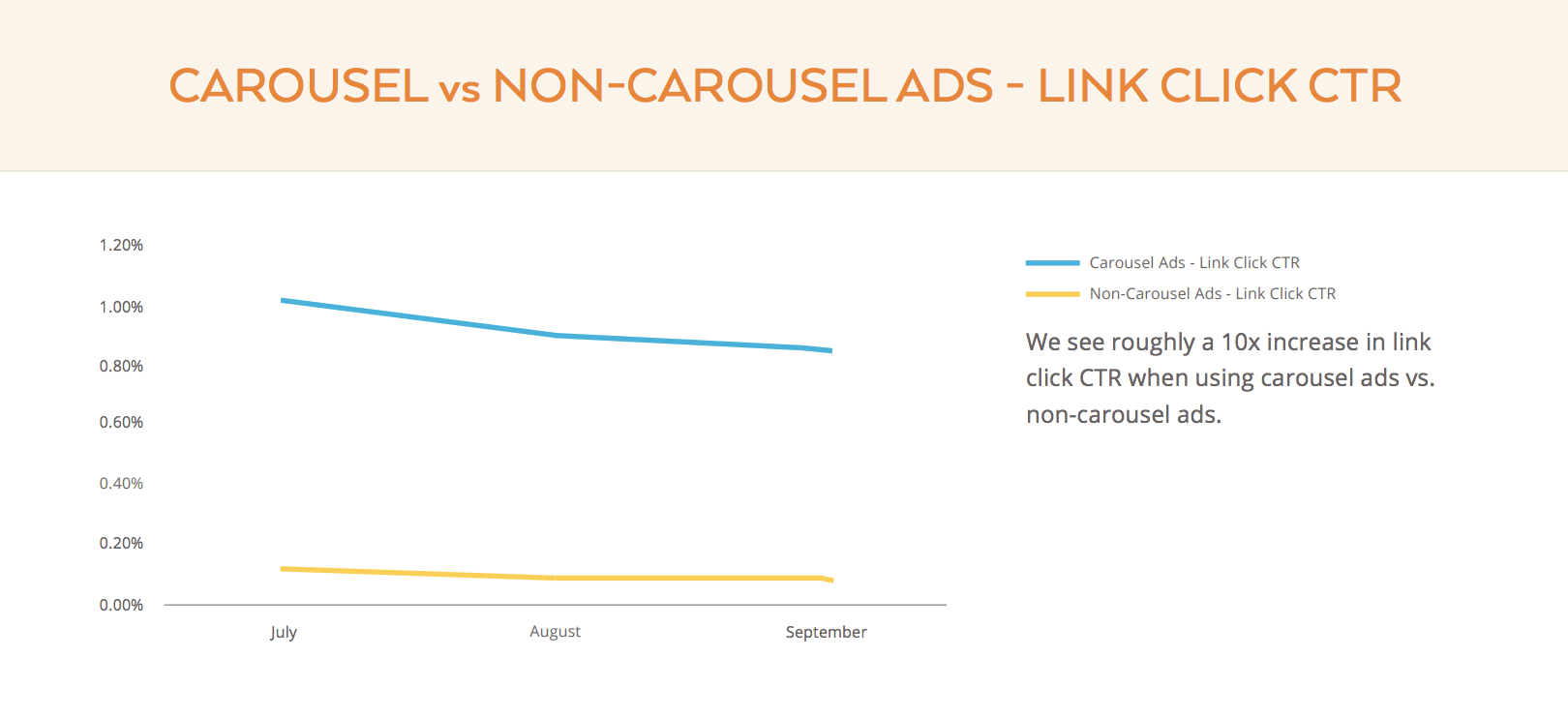
The carousel refers to how the ad is displayed in a user’s news feed and allows you to show up to 10 images or videos in one ad, each with its own link. You can use this to highlight different classes and offers and test which image is the most effective.
When your ad is up and running, Facebook’s Ad Manager is the hub of all your campaign activities. If you need to get to grips with the Ad Manager, check out this tutorial. The Ads Manager allows you to track campaign spend and measure the success of each one. So once you’ve set your goal, defined your audience and campaign objectives; your metrics are all in once place. From here, you can make strategic decisions for future campaigns.
3. Tried and Tested Creative
With a strategy in place and a defined audience, the next step is to create a campaign that resonates with your target audience. This means using certain images/video and copy and tailoring the ads to appeal to that specific group.
When it comes to the ad creative, answer these 3 questions before you make any decisions:
- Who is the target audience for this ad?
- What value does the ad offer?
- What would make the audience take action?
Keep in mind that you only have a few seconds to grab your audience’s attention with your ad, so the value proposition and call to action need to be as clear and concise as possible. Save the long copy on ‘the benefits of joining a gym’ for your blog – keep it short and snappy on Facebook!
The key to effective campaigns on Facebook is to test what works. Try a few different combinations of images, video and copy to see which gives the best results. Experiment with reach by posting the ad organically on your page. If you’re torn between what might work and can’t decide which version to use or test in the first instance – ask your existing page followers for their opinion. You already want to attract more people like them, so their opinion is valuable.
While it’s up to you to test and discover what makes the best creative ad content for your studio, there are some basic elements that you should follow every time. In the next section, we’ll look at a couple of great Facebook ads to demonstrate what well-structured creative looks like.
4. Facebook Ads Best Practices
Advertising on Facebook opens up a world of marketing opportunities for your fitness brand; you just have to get it right. Once you’ve got your marketing strategy locked down and you know your audience, it all comes down to the ad content itself. Make sure you keep 3 key elements in mind when you create your gym ads:
- Make sure the image/content is visually appealing
- Entice users with value
- Include a clear call to action
Let’s take a look at a couple of examples from 2 brands with some great Facebook advertising.
Nike
This example from Nike has carefully ticked all of these boxes. The contrasting color used in the carousel is attention-grabbing straight away. The apparent value offered is that users can personalize their own unique design, and the CTA to learn more takes you to the relevant page on their website.
The copy itself is short and straight to the point; as it should be. The content of your ad should do the talking and the text that accompanies it should be concise and relevant. Nike has also cleverly included a link within the copy as although the entire ad is clickable; some people might not know.
Adidas
In 2010, Adidas football wanted to be the most talked-about sports brand during the World Cup. With Facebook advertising, they did just that.
Their global campaign drove audiences to the Adidas Football Page. Here, users were able to interact with content from the event, watch unique videos, play games, and learn about the brands’ new products.
Through strategic targeting, the Facebook page reached over 1 million fans, with over 860,000 interactions. The videos posted as part of the campaign were viewed over 1 million times and across multiple countries, brand awareness grew between 8% and 21%.
Adidas might be a high-profile global brand, but these results are seriously impressive nonetheless. And, they prove that with a well-planned strategy, targeted audience, and high-quality content; Facebook Ads lead to success.
In Summary
Whichever way you look at it, Gary Vaynerchuk’s description of Facebook as “the biggest, baddest social network” is still relevant. And its advertising potential surpasses that of other social media platforms.
After all, these ‘other platforms’ don’t have 2 billion active monthly users who are throwing their personal information and preferences at your fitness business. It opens up your marketing opportunities to the largest audience in the world, at a price other forms of online advertising just can’t compete with. There is no equal to what Facebook can do for your advertising.
When executed well, a Facebook ad campaign that drives potential and existing members to unique content can rapidly increase engagement, connections, and raise brand awareness. We now know that with a focused and strategic approach, advertising on Facebook has enormous marketing potential for your fitness business.
So if you’re not advertising to your desired audience on Facebook, what are you doing?
Table of contents



